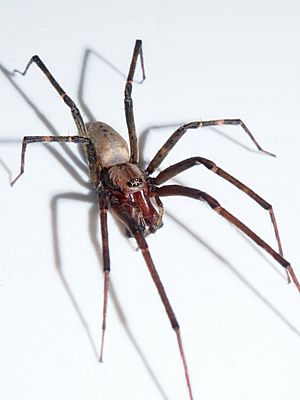Cambridgea foliata facts for kids
Cambridgea foliata is a fascinating spider often called the New Zealand sheet-web spider. It's a special type of spider that lives only in New Zealand. You can find these spiders mostly on the North Island. They are active at night and live in trees, building large, flat, sheet-like webs. These webs also have many "knock-down" threads that help them catch prey.
Quick facts for kids Cambridgea foliata |
|
|---|---|
 |
|
| Scientific classification |
What Does the New Zealand Sheet-Web Spider Look Like?
The New Zealand sheet-web spider has a body that is reddish-brown. This part is called the cephalothorax, which is like its head and chest combined. Its abdomen, or back part, is a greyish-yellow color.
Both male and female spiders are about the same size. Their cephalothorax is usually around 5.8 millimeters wide. However, male spiders have much longer chelicerae. These are like their jaws, which they use for holding prey or fighting.
Some other types of Cambridgea spiders have a special organ that makes a sound, like a tiny violin. But the male New Zealand sheet-web spider does not have this sound-making organ.
How Do Male Spiders Find a Mate?
During the summer, adult male spiders leave their own webs. They go searching for female spiders to mate with. Sometimes, they might even wander into people's houses by mistake!
When a male spider finds a female's web, he will try to protect it. He uses his front legs and his long chelicerae to defend the web and the female. If another male spider tries to come near, they might have a contest. The biggest male spiders are usually the best at protecting the webs and winning these contests.

